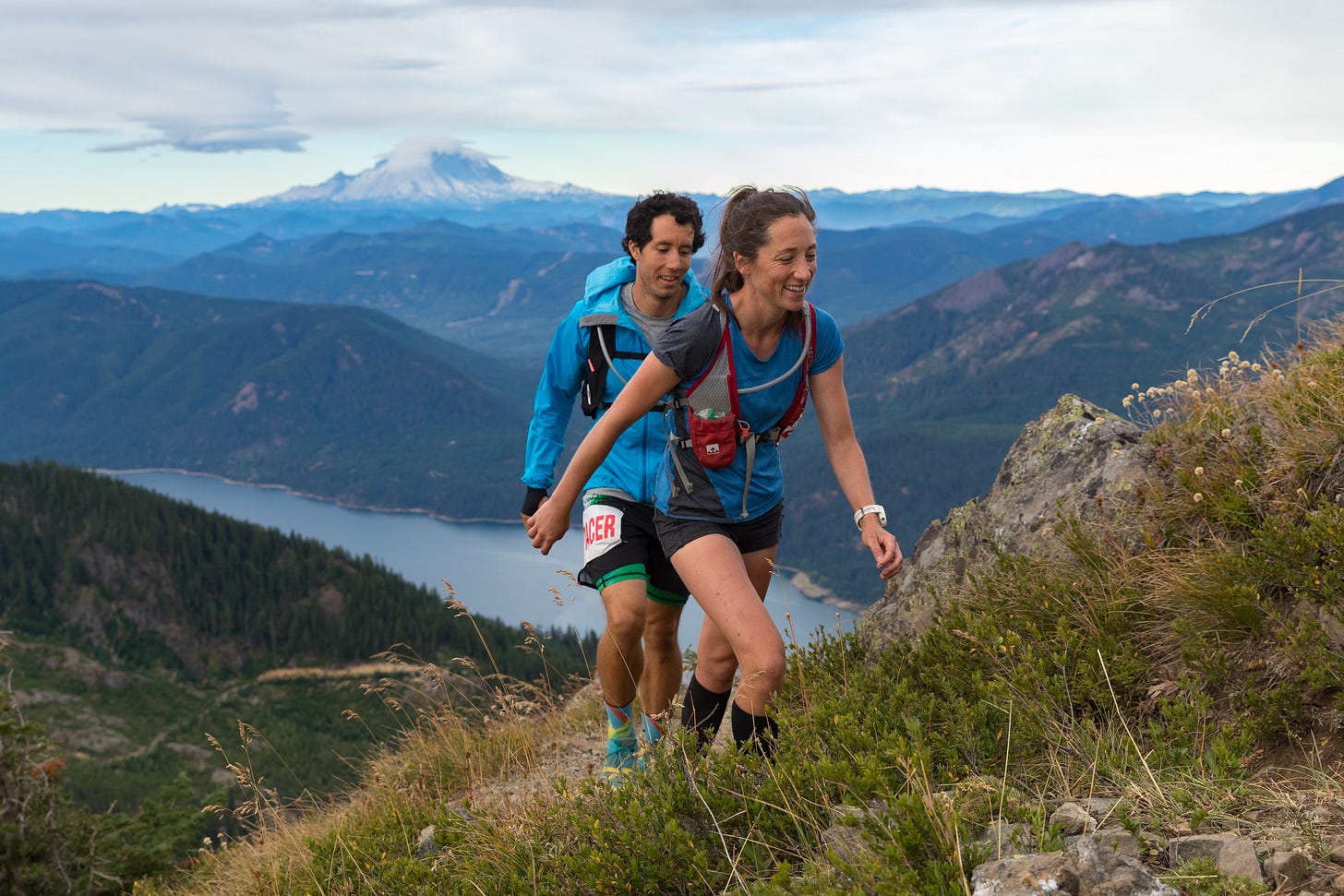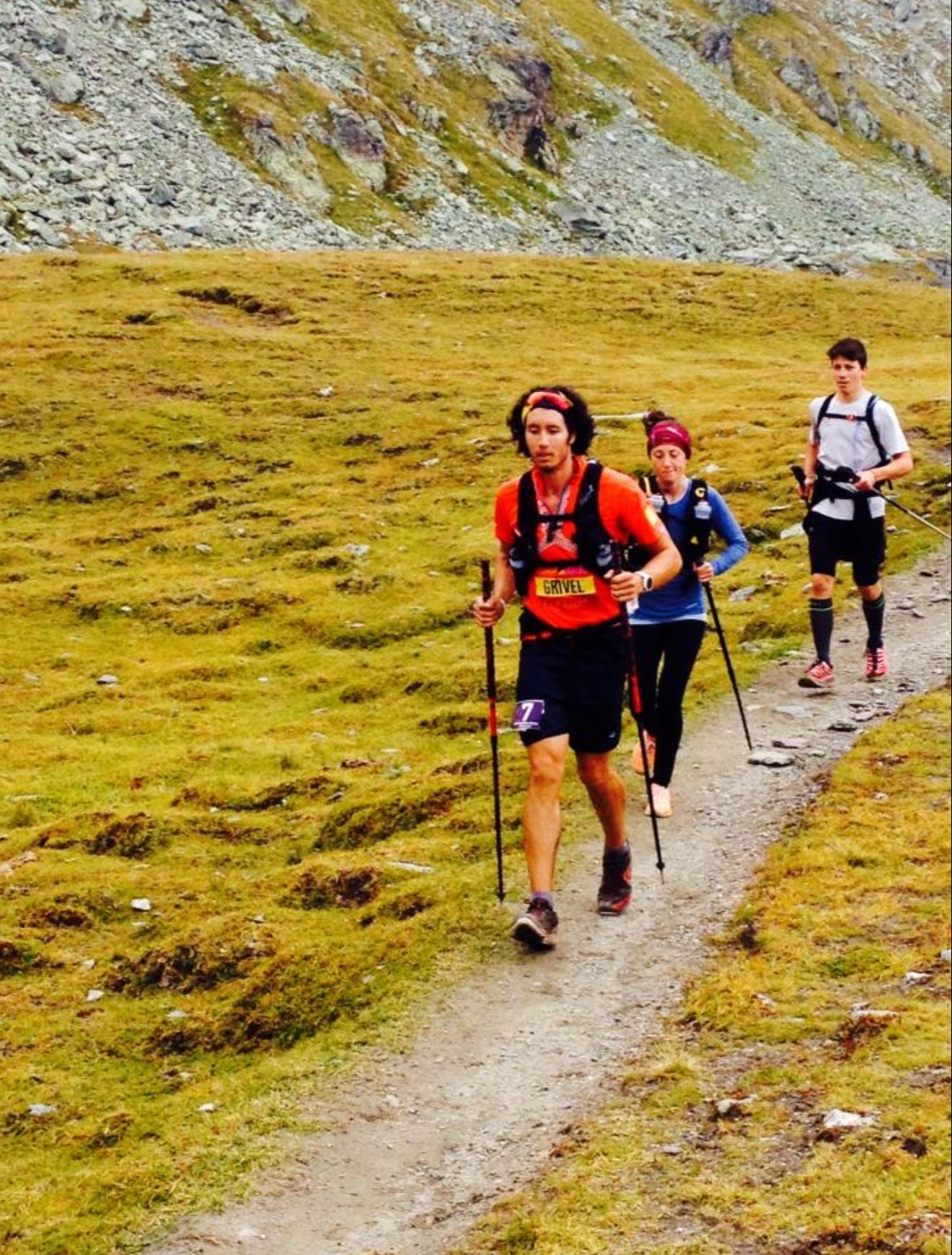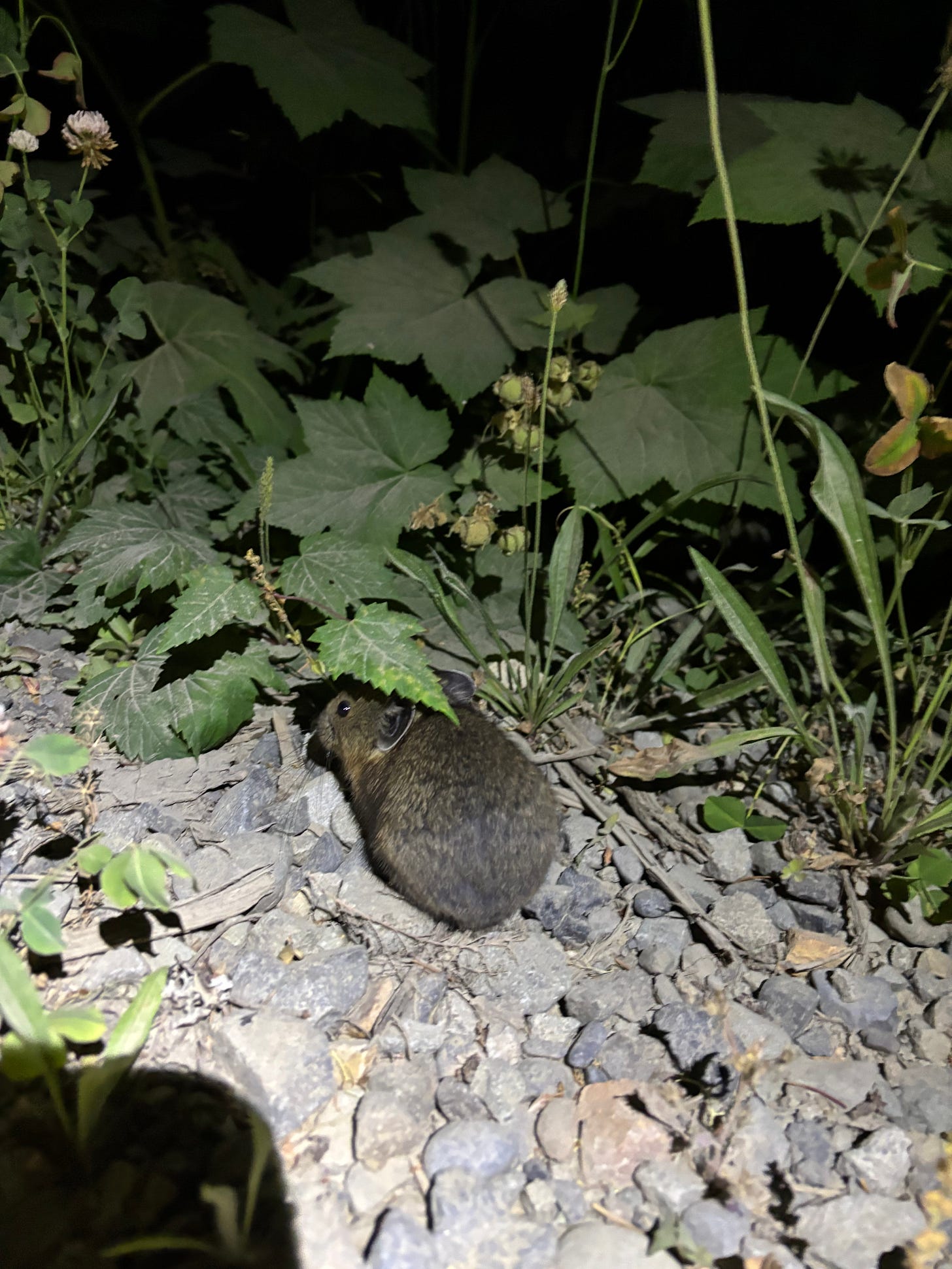Pacing Nick for Cascade Crest 100
Or, how a pacer can help their runner stay positive and compassionate with themselves
This past weekend, Nick ran Cascade Crest 100 in Easton, Washington. It was his A race of the year, meaning that his training and racing schedule for 2025 have been mostly geared toward this race.
Cascade Crest is a burly course. Though we’ve both run 100-mile races with more elevation gain, Cascade Crest’s course is largely technical with several very punchy climbs and a downhill finish that feels never-ending. The race also starts at 9 a.m., which means hitting the initial climb up Goat Peak in the heat of the day.
Nick paced me when I ran this race in 2016, so I was thrilled to have the chance to swap roles this year. Our friend, Josh, would accompany Nick from mile 54 (the first time a pacer can jump in) to mile 69, then I would take over to the finish.
I’ll link to Nick’s race recap once he’s published it if you’d like to read his account of the race. I highly recommend subscribing to his Substack, too.

Despite crewing each other for races since 2013, I’ve only paced Nick twice: once for a 12-mile section of Kodiak 100K a few years ago and another time when I was asked to check in on Nick during the 2014 Tor des Geants, a 205-mile race with nearly 80,000 feet of elevation gain. One of his team sponsor’s had thought he was struggling and wanted me to check in on him. That involved a drive on very treacherous mountain-side Italian roads, a stop to pick up an umbrella(?) at the driver’s friend’s house, a steep climb directly up a mountainside (no trail), and then finding Nick huddled in a refugio, at one of the course’s race checkpoints. After assuring the person that Nick was fine, I had to get back down the mountain and back with the rest of our crew which meant running with Nick to the next aid station. Someone handed me a pack with water and running poles and apparently I was good to pace for the next few hours. I had a total of seven almonds in my pocket, not predicting that I’d be pacing anyone let alone running. I followed Nick down the very long, steep descent and into the night. Nick made it on just fine, ultimately taking second place, the highest an American has ever placed in the race.

This time, I knew I was pacing and would be prepared.
If you haven’t paced a runner before, or want to know more about why pacers can be so beneficial, I recommend Corrine Malcolm’s article here. While there is some debate about the use of pacers within the sport, I’m not interested in that conversation. I’d rather have more experiences to share with friends and loved ones than less, and I’d rather find my potential (or help find another’s potential) than judge the difficulty of a run by the use of pacers or not.
Pacers cannot carry their runner’s gear (known as muling), but they can be there as moral support. In some cases, a pacer’s presence can help from a safety perspective. Having Nick pace me through the night of each of my 100-mile races has made me feel safer than if I were to run solo, particularly in remote locations.
Some additional ways in which a pacer can help:
reminding runner to eat or drink
ensuring runner is following the course correctly
reminding runner of his/her goals
knowing the length/profile of the race
providing encouragement
This last point in particular hinges upon knowing your runner and/or speaking with them beforehand. Luckily, Nick and I are married, live together, train together, and have raced around or with each other for the last 13 years so knowing what the other needs is mostly intuitive at this point. Even so, it’s helpful to clarify exactly what your runner wants out of a race.
A few days before the event, I asked Nick his specific goals. He told me, “I’d like to finish in 18-20 hours,” and gave me a pacing chart that he’d created for these two time schedules. Having a goal time was a start, but I knew that he needed a framework beyond this: what happened if he fell off of his time goals? Did he want to finish no matter what (granted he did not get injured or ill)? Did he care about placement or position during the race or at the finish? Did he want me to tell him how many miles we had left, or how much climbing we still had to get through?
What I didn’t have to ask him was how he wanted me to pace; that is, whether he wanted the “tough love” approach (which I personally don’t love under any circumstance) or the empathetic one. Sarah Lavender-Smith wrote a terrific piece on Nick’s athletic journey for iRunFar which I highly recommend. While some things have changed since it was published in 2019 (Nick’s borderline personality symptoms are very much background noise at this point and I changed my name from our married name, de la Rosa, back to my maiden name, Belzberg), Sarah’s article demonstrates the sort of mindset that Nick relied on (and the one that was encouraged) in the first part of his running journey. As he reminds me now, he would tell himself “this ain’t no sob story” during races like HURT 100 and Badwater 135 as a means to motivate himself.
This isn’t the sort of self-talk Nick uses anymore, and it’s not the form of encouragement I use either. Rather than focus on whether or not he’d made his time goals as he came through each aid station, Josh and I told Nick how great he looked. And he did—he’d eaten all of his gels and finished his water between aid stations and seemed positive at each aid station we could see him at.
The Race
Josh paced Nick from Hyak to Lake Kachess (mile 54 to 69); I’d take Nick the final 31 miles to the finish. While Nick was a bit off his time goal as he came into the Lake Kachess aid station, he still seemed positive. We focused on refilling him with gels, grabbing him some hot miso soup from the aid station volunteers, and readying his headlamp. Within a few minutes, Nick and I were off.
Even though it had been nine years, I remembered this next section well: the Trail from Hell. This five-mile section is mostly comprised of downed trees, freezing cold creeks, roots, and slick, off-camber trail. In 2016, the trail was particularly bad. We came through in the dead of the night, Nick pacing me and positioned ahead, while another runner, Jack, who we met during the race, followed behind. As we slogged our way along the trail, Nick and I startled a ground wasp nest—unfortunately, Jack was attacked by the wasps we had disturbed. His yelps punctuated the otherwise silent night.
The Trail from Hell has been improved upon since then, and Nick made good work of it. We briefly lost the trail at the beginning due to course vandalism (where people intentionally or unintentionally remove or cut course markings) and lost five minutes trying to find the correct way. But Nick remained calm, choosing instead to re-frame the experience in a positive way:
Instead of thinking: We just lost 5 minutes trying to find the course
He re-framed it as: I’m glad we took the time to ensure we were going the right direction.
We arrived at mile 75 in good spirits. With the Trail from Hell behind us, we could look forward to a smooth section of fireroad for several miles. Without discussing it, we started running and didn’t stop. Nick jogged almost the entire 3,000 foot climb up to Mount Thorpe.

“Am I moving fast enough?” He asked. I was in front of him, as he preferred me to stay ahead on the fireroad.
“You’re moving so well!” I replied. “I can’t believe you’re still running all of this!”
He seemed satisfied with that response, any doubts that had arisen now quelled.
We carried on like this, all the way up until the break off to Mount Thorpe at 5,500 feet. As we began the descent down, two runners were coming up.
“That’s third and fourth,” Nick said, suddenly quickening his pace. I didn’t agree—I thought that was a runner with a pacer behind him but decided not to argue. I didn’t want to be wrong and leave room for disappointment if it was third and fourth and they ultimately passed Nick, and I also wanted him to have some extra motivation to push. Maybe it was better if he thought two runners were immediately behind him and he needed to push that much more to stay in contention for the podium.
Over the next ten miles, up and down every Cardiac Needle, Nick moved with purpose. So far we’d held off the other runners, but we were also several hours from the finish considering the long, technical descent ahead. As we ascended a steep pitch and Nick transitioned from a run into a strong hike, he asked me, “Is it okay that I’m hiking this?”
I wanted to remain nonjudgmental and to help him feel good about himself, so I asked him a question in response: “Are you moving the best that you can right now?”
He’d pause for a few moments before replying. “Yes,” he said, “I’m moving as fast as I can.”
“Then that’s perfect. That’s all you have to do.”
We didn’t speak much. I figured Nick needed to save his energy for the remaining miles of this race. I also knew from having run 100 mile races in the past myself that I had no ability to keep up a conversation or even stay present with what my pacer was saying this late in the race.
At mile 93, while crossing another freezing creek, I heard voices from behind: the two runners. They were gaining on us.
Nick heard it, too, because he was running a little faster. It wouldn’t be fast enough to outrun them though.
“I’m so proud of you,” I told him. “You’re running such a smart, strong race.”
These were the kinds of things I wanted to hear in races, and these were the same reassurances he’d given me during harder points of my past races, too.
Within a few minutes they were suddenly behind us and just as quickly they had passed. I reiterated again how proud I was of him and we continued on.
I’ll leave the end of the race to Nick (I’ll link to this Substack when he publishes it this week), but I can tell you that it was so meaningful to be able to run with him for the final 31 miles and into the finish.
I wanted to let Nick have this moment to himself but he grabbed my hand and we ran through the finish together. I’m so proud of how hard he’s worked to reshape his athletic identity and found more compassionate (and ultimately far more helpful) ways in which to speak to himself during races. This inner voice now extends far beyond just racing. Video by Claire DeVoe.



Jade, great report and wasps be damned! I still have fond memories of sharing miles with you in our early 100 milers.
Great story Jade! Pacing and crewing is HARD. You not only have your self to take of, you have the runner, your primary job. Congrats to you on successfully pacing for Nick! And congrats to Nick on pushing through to a finish on a badass course.